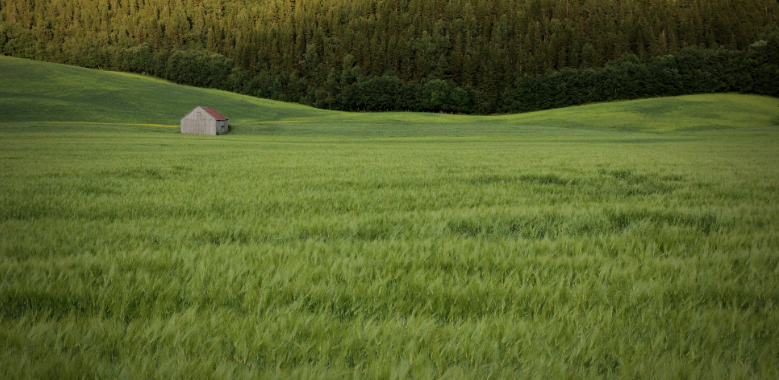Linkages between landscapes and human well-being: An empirical exploration with short interviews
There is increasing acknowledgement that human well-being is tightly linked to the natural environment. HERCULES and PECS researchers Claudia Bieling and Tobias Plieninger address this topic in a new paper.

Photo: Jan Hammershaug/Wikipedia commons
Together with Heidemarie Pirker and Christian R. Vogl, Claudia Bieling and Tobias Plieninger investigate the linkages people perceive between biophysical features of a specific area and their subjective well-being.
Moreover, they analyse how these linkages differ across socio-cultural variables and biophysical contexts.
The rest of the text is taken from the Cultural Landscapes blog, which is hosted by the Hercules website:
“What makes life good is one of humankind’s most fundamental questions. Given recent experiences of extreme droughts, soil degradation and a multitude of other existent or foreboding ecological crises around the world, there is increasing acknowledgement that human well-being is tightly linked to the natural environment. However, empirical studies that address this topic in a comprehensive manner have only recently evolved, most notably with the Millennium Ecosystem Assessment (MA 2005). Following a landscape approach with a focus on the cognitive dimension of the human-nature nexus, the HERCULES researchers Claudia Bieling and Tobias Plieninger, together with Heidemarie Pirker and Christian R. Vogl, address this topic in a new paper in “Ecological Economics” (Bieling et al. 2014, http://dx.doi.org/10.1016/j.ecolecon.2014.05.013).
We investigate the linkages people perceive between biophysical features of a specific area and their subjective well-being. Moreover, we analyse how these linkages differ across socio-cultural variables and biophysical contexts. Finally, with the aim of advancing concepts for the understanding of human-nature relationships, the ecosystem services framework and the cultural values model developed for landscapes (Stephenson 2008) are evaluated with regards to the inductive empirical results.
In order to span a range of various human-nature relationships, the study is directed towards four landscapes in Central Europe that contrast regarding variables such as geomorphology, population density or land use: Freiburg/Black Forest, Swabian Alb and Upper Lusatia in Germany; Hohe Tauern in Austria. It applies an open, rapid and quantitative approach towards grasping the linkages between landscapes and human well-being. Following the idea of freelisting that is common in ethnographic cultural domain analysis, interviews with 262 respondents built on a single question: “How does the landscape here contribute to your well-being? Please briefly report anything that comes to your mind”.
Respondents mentioned between one and 26 different aspects of how the local landscape is linked to their well-being, resulting in a total of 109 different items. This includes a broad range of issues that refer to ecosystem features, activities and perceptions and values. The most salient item is ‘beauty’, followed by ‘naturalness, nature’, ‘mountains’, ‘tranquility’, ‘forest, woodland’, ‘hiking’ and ‘place attachment, feeling at home’. Overall, the interviews provided overwhelming evidence regarding nonmaterial values connected to landscapes, whereas aspects like the provision of food were rarely mentioned. Respondents frequently emphasized biophysical landscape features. This indicates that the material world indeed matters and that well-being is not a mere product of social construction.
Another insight to be taken out of the study is that practices, activities, and experiences are formative for close linkages between landscapes and well-being. Asked about these linkages, respondents reported on manifold ways of engaging with the landscape, such as in terms of doing outdoor sports, taking pictures or appreciating a view; moreover, a statistical analysis shows that those who are involved in such practices are more likely to hold rich landscape relationships. Results contrasted for different respondent groups like farmers and visitors, but most strongly for the four study sites, with people pointing to different landscape features of their regions while also depicting some specific landscape practices and stressing different landscape values, pointing for instance to the particular role of farming in the Hohe Tauern mountains or to the ponds and lakes in Upper Lusatia.
The results accord with the conceptual outline of the cultural values model that distinguishes three dimensions of landscape-related values: forms, practices and relationships. To the contrary, the empirical findings fit to a far lesser degree into the ecosystem services framework. The latter concept conflicts with the holistic character of landscape-related benefits and values found, particularly regarding the nonmaterial aspects labelled as cultural ecosystem services. Moreover, the distinction of ecosystem services from the biophysical features that deliver them and most importantly the distinction of services from determinants and components of well-being are not in line with people’s perceptions and ways of thinking.
Contributions to human well-being are associated with specific features of the material environment but are simultaneously prompted by practices and experiences gathered in the course of engaging with landscapes. Taking up this main insight, we conclude that, in order to safeguard and foster human well-being, the preservation and sustainable development of biophysical landscape features has to be pursued, not just in their own right, but also because of the role they play in engendering valued practices and relationships. Moreover, and up to now more rarely considered, the relevance of experiential factors calls for raising public awareness concerning landscapes, fostering knowledge in the course of environmental education and providing manifold opportunities for people to engage with their natural surroundings.
Claudia Bieling,
University of Freiburg
Chair for Landscape Management”
The full paper – Bieling, C., Plieninger, T., Pirker, H., Vogl, C.R., 2014. Linkages between landscapes and human well-being: An empirical exploration with short interviews. Ecol. Econ. 105, 19–30 – is available here: http://www.sciencedirect.com/science/article/pii/S0921800914001645
